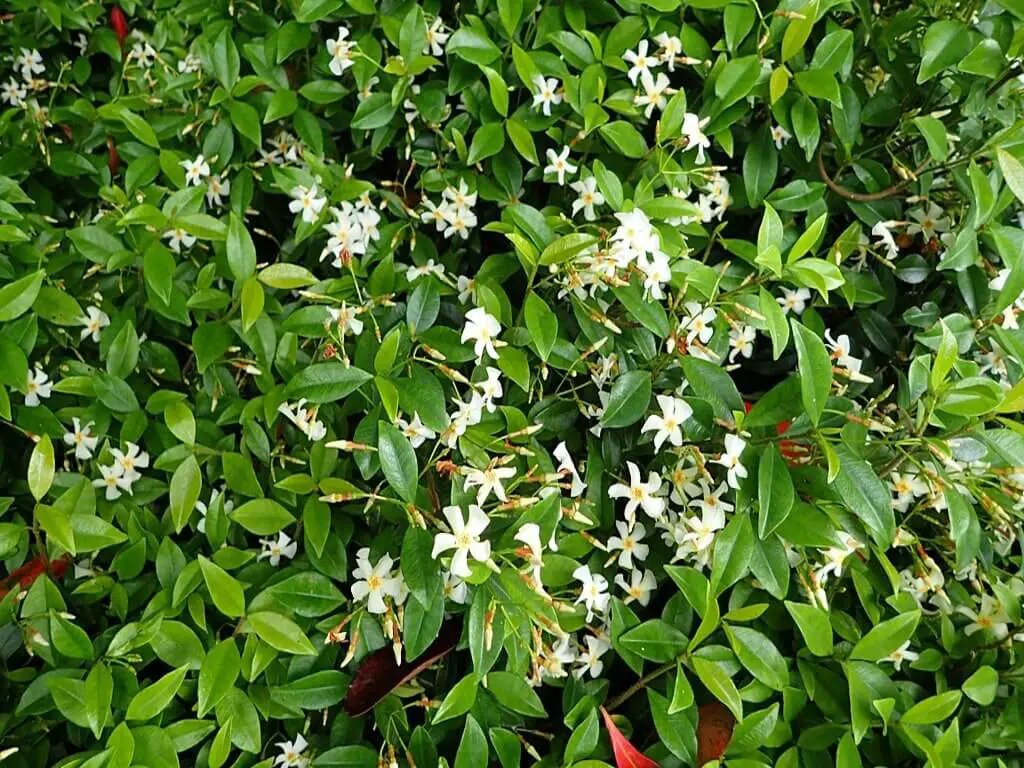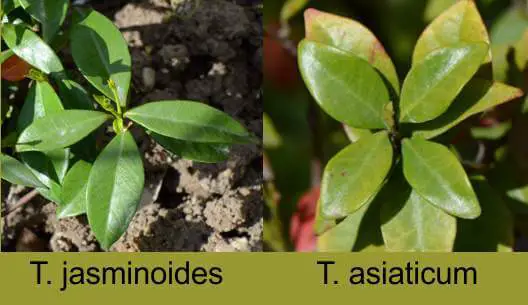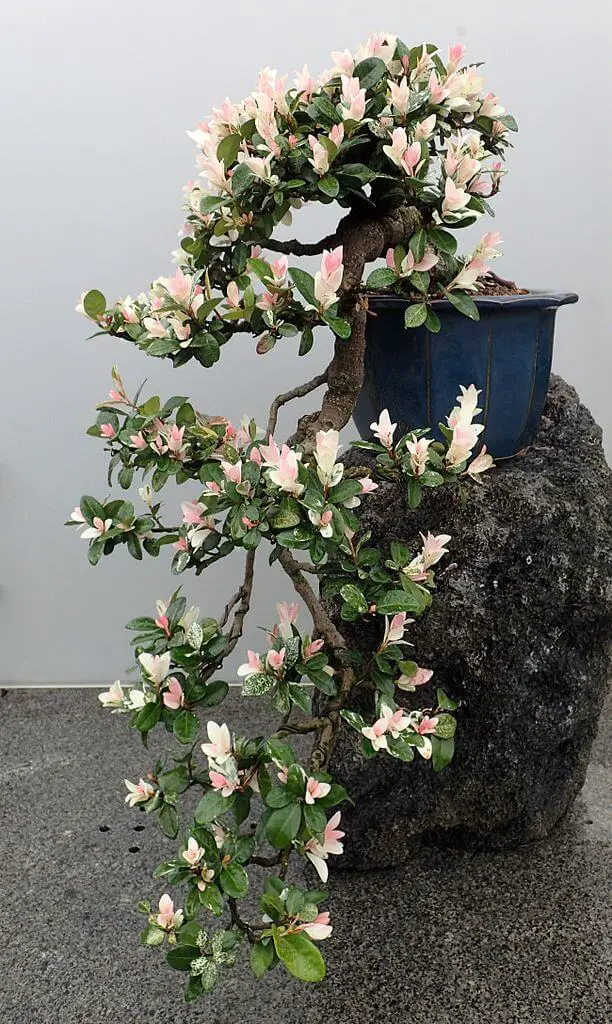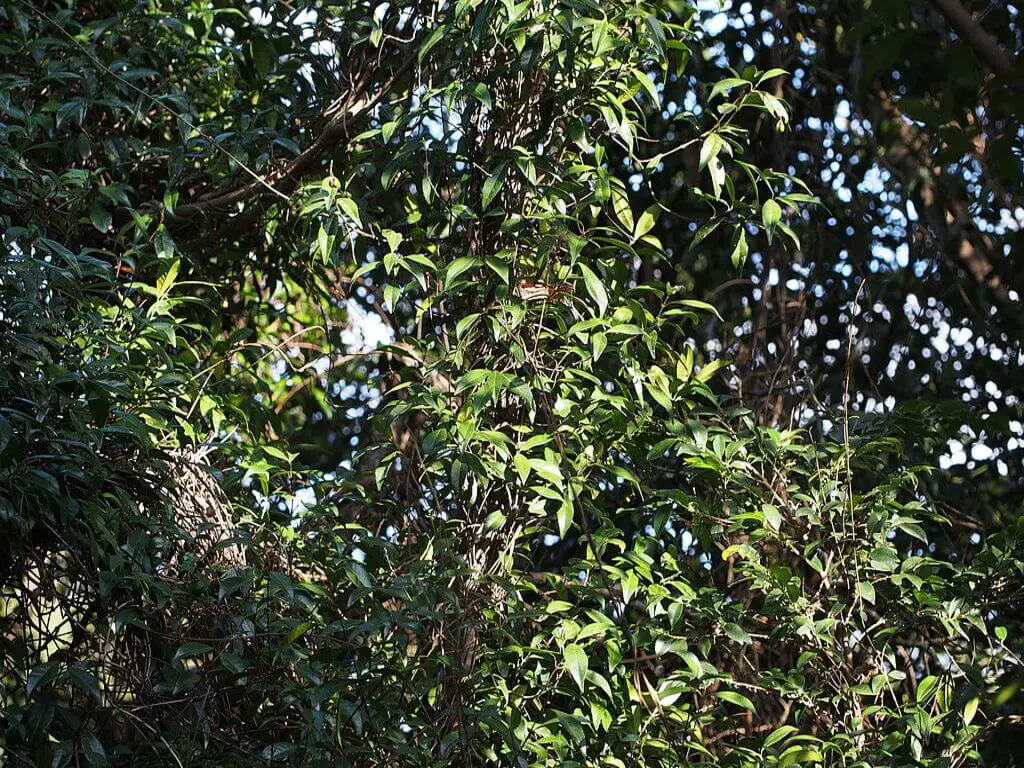How to Grow Asiatic Jasmine
Asiatic Jasmine (Trachelospermum asiaticum) is a plant species in the Apocynaceae family. This plant is indigenous to the Asian continent, particularly Japan and Korea. It also has various names including Asian jasmine, dwarf jasmine, and minima jasmine.
This article focuses on Asiatic jasmine its characteristics, propagation, caring, varieties and uses.
Generally, gardeners grow these plants as ground covers. They can control soil erosions on hillsides and slopes to some extent. They grow radially in sunny or shady embankments, canopies of large trees shades or overhead structures, etc., In addition, these plants also serve well in container gardens and hanging pots as spiller plants.
However, it is advisable, not to growing them in small spaces. These plants are quick spreaders. Small areas cannot confine them unless pruned constantly.
Table of Contents
Characteristics of Asiatic Jasmine

Photo by Krzysztof Ziarnek, Kenraiz (Wikimedia Commons) (CC BY-SA 4.0)
Asiatic jasmine is easy to grow plant that spreads quickly. It has small glossy leaves that are usually dark green in color. They sprout from reddish-brown stems (vines). You can grow them against fences or sheltered walls.
Usually, these plants bloom white, the five-petaled, small, and delicate flowers. These flowers have yellow central heads. Normally, the blooming period is from the later part of spring to summer. These flowers exhibit a “jasmine” scent that fills the air around the space.
However, the flowers won’t blossom in very hot temperatures. very cool winters can kill the plant. Hence, it is advisable to grow these plants in regions with temperate climates.
In spite of being ground covers, these plants cannot tolerate the foot traffic or stomping well. But there are other flowering plants and culinary herbs that can handle these scenarios better. You can find more details in the guides.

Photo by Pancrat Kenraiz (Wikimedia Commons) (CC BY-SA 3.0)
There is also another plant in the market which people confuse Asiatic jasmine with. It is called confederate jasmine or star jasmine. Its botanical name is Trachelospermum jasminoides. This plant has slightly different characteristics. It grows more abruptly and can flower in abundance.
History
Von Siebold, a Bavarian naturalist visited japan during the time period between 1823 and 1829. Following his visit, in 1846, Joseph Gerhard Zuccarini (German botanist) assisted him in describing Asiatic jasmine in his book “Flora Japonica”. They named this plant “Malouetia Asiatica” in this book
Zuccarini also described other plants, discovered in several other areas, including Mexico.
However, “Flora Japonica” was incomplete, even after its official publishing in 1835. After his demise, F. A. W. Miquel completed it in 1870.
Later, Takenoshin Nakai (Japanese botanist), reclassified the plant species in accordance with modern taxonomy.
Propagation of Asiatic Jasmine

Photo by Krzysztof Ziarnek, Kenraiz (Wikimedia Commons) (CC BY-SA 4.0)
Asiatic jasmine is usually hardy in USDA zones 7b-10. Except for wet and constantly soggy soils, these plants can thrive in various types of common soils. However, they grow best in acidic type to slightly alkaline type soils that have Ph values between 5.5 -7.0. Generally, most US garden soils fall in this range.
You can grow them even in large shaded areas. So, sunlight may not be a crucial criterion to grow them.
Generally, the tilting of soil is not necessary. This may lead to erosion especially on slopes. However, if you personally prefer soil tilting, we highly recommend you to add a landscape weed preventer to the tilted soil. It is because even some dormant weeds can flourish using the resources of tilted soils.
These plants must be spaced at least 18 to 24 inches apart. So, consider the volume of the land before mass planting.
Normally, gardeners do not grow these plants from seeds. We have listed other methods of propagation below:
From Cuttings
Select a pot that has good drainage facilities. Generally, we recommend you to use biodegradable pots. Fill it up with damp sand. Create a central hole with a sharp object like a pencil.
Using good quality shears, cut off 6-inch shoot from top. Snip off the leaves at the bottom part of the shoot. Insert it into a good quality rooting medium. Some gardeners prefer powdered rooting hormone. But, you can use your preferred chemical.
After that, place the cutting in the central hole firmly and fill the hole. water well. Cover this arrangement with a plastic plant cover. Water regularly. You can place this arrangement in shady areas that receive indirect sunlight. It doesn’t matter whether indoors or outdoors. After a couple of months, the plants will establish themselves. Then you can transplant them to the gardens
Alternatively, you can also grow the shoots in a glass filled water. You can find the root development in about a month’s time. After that, transfer them to pots. Make sure to fill the pots with good quality potting soil. The plants may again require more than a month to establish themselves in the pot.
In this method, approximately after 8 -10 weeks, the plants will establish themselves. After that, you can transplant them into the garden.
From Seedlings
You can purchase Asiatic jasmine seedlings from online stores like amazon or nurseries. Make sure to purchase from a reputed seller who has good ratings. After that, you can transplant them easily in any desired location.
We recommend you to start this process in the fall or spring. Avoid transplanting in summer, especially if you live in warmer regions.
Just dig a hole measuring approximately the same size as that of the purchased containers (seedling). Then, simply place the jasmine plug into the hole and refill it.
After planting, water abundantly so as to soak a minimum of 6 inches deep soil. We also recommend you to mix the Root Stimulator solution with water. This helps in quick root formations and healthy root developments. As a result, you can expect the plants to grow healthy.
As described previously, maintain at least 18 to 24 inches distance in-between plants. During the first month, water twice a week. After that, water at least once a week for about 7 – 8 weeks.
Alternatively, if you already grow these plants in the garden, you can try layering. This is also one of the successful methods of propagation.
Caring of Asiatic Jasmine

Photo by harum.koh (Wikimedia Commons) (CC BY-SA 2.0)
Normally, the gardeners feed Asiatic jasmine plants with organic matter during the early spring and late summer. If you determine to promote more green foliage, amend the soil with sulfur. We also recommend you stop fertilizing a couple of months prior to the frost.
During the initial growth stages, these plants prefer moist soils. However, Deep soaking less often, is advisable than vague watering every day. Usually, these plants go dormant during winter. Hence, they require very little water to survive in winter. Avoid overwatering in this scenario.
However, after establishing, these plants exhibit excellent drought-tolerant capabilities. They do not prefer constantly soggy soils at these stages. So, water only during long dry spells so as to keep the soil just damp to moist.
Avoid overwatering at any all time. It may lead to root rots and other plant diseases.
Pruning
Normally, you only require to prune these plants, if they grow cross border. You can also prune the root-bound nursery pot plants or grown ones up to 50 %, for promoting more denser growth.
It is advisable to avoid pruning a couple of months before the frost. Other than that, you can prune them anytime around the year.
We recommend you to use good quality shears or a motorized weed trimmer for pruning. This helps to prevent unexpected damages to the plants.
Cultivars of Asiatic Jasmine
There are many cultivars of Asiatic jasmine available in the market. Down below, we have listed some of its popular varieties :
Bronze Beauty
This cultivar has almost similar characteristics as that of Trachelospermum asiaticum. It forms an excellent ground cover for any given space. This plant is famous for its bronzy colored leaves with creamy margins. It readily provides coppery looks from a distance.
If you are looking for a plant that provides distinguished looks, this cultivar may suit your desires well.
Goshiki
Being drought-tolerant, this cultivar loves to grow under the sun. it is a compact variety that grows slowly. This cultivar sprouts tricolored leaves which mostly have white, pink, and dark green shades. Hence, they can provide beautiful contrast looks when interplanted with other cultivars as ground covers.
The flowers are usually white and fragrant. Usually, their blooming ratio is very less. This cultivar provides excellent looks in hanging baskets.
Snow and Summer
This variety is one of the most popular varieties of Trachelospermum asiaticum. it is a medium-sized evergreen shrub known for its beautiful variegated foliage. The foliage usually emerges in pink color. After that, it turns white. Later, it changes to variegated white and green.
This cultivar blooms in summer. The beautiful white flowers exhibit a sweet scent that fills the surrounding air.
You can interplant this cultivar with other varieties to add contrasting brightness to thick ground covers. You can also easily train this variety to spiral around the fences as long and catchy vines.
Other Cultivars
The other popular cultivars include the Longleaf, Variegatum, and Summer Sunset that can enhance the ground cover experience of your spaces.
Pests and Diseases
Normally, Asiatic jasmine is bothered by common plant pests. It is mostly free from any plant diseases. Caring for these plants with the above-mentioned methods can prevent most of the common pests and diseases. However, we recommend you to keep a dedicated guide handy to deal with them.
Pests
There are different types of common pests that affect these plants. Mealybugs, Glasshouse red spider mite, Japanese beetles, Cushion scale, and other like pests may bother these plants occasionally.
If you confirm pest infection, first try non-toxic solutions. Treat the pests with water and dish soap mixture. You can also try neem oil sprays. In most cases, these treatments are enough to drive out the pests.
Diseases
In general, Asiatic jasmine is less frequently bothered by diseases. Just proper caring is adequate as mentioned above in the article is adequate to prevent most of the common problems.
During the intense summer heat, accompanied by wet conditions, leaf spots may affect these plants. This disease is caused by fungus pathogens that belong to the Cercospora genus. This disease tends to spread sporadically with water to other plants.
The affected plants initially have brown spots on foliage. Later, the leaves discolor and fall off.
You can treat this disease by just controlling the moisture content. Water aiming roots, avoiding foliage. If the plant is affected severely, you can use serenade fungicides to cure the disease.
Uses

Photo by GFDL (Wikimedia Commons) (CC BY-SA 3.0)
Naturally, the dark green cover of Asiatic jasmine enhances looks on slopes, banks, borders, and other like areas. The dense foliage controls erosion to some extent and also the weed spread.
It climbs fences, trellis, arbors, and like spaces spirally. As a result, it provides both beautiful decorative looks and privacy to some extent. These creeper plants also serve well in tall planters and hanging baskets.
Royal Horticultural Society appreciated Asiatic jasmine with its prestigious “Award of Garden Merit” for its ornamental character.
In addition, this plant also attracts songbirds and butterflies. It is known for its deer-resistant capabilities too.
Just plant them in a space outside the open window. You can enjoy the beautiful scenarios as well as the pleasant scent of its showy flowers.
Similar Posts
How to Grow Spearmint Plant in Gardens
How to Grow Purslane Plant (Portulaca Oleracea) in Gardens

